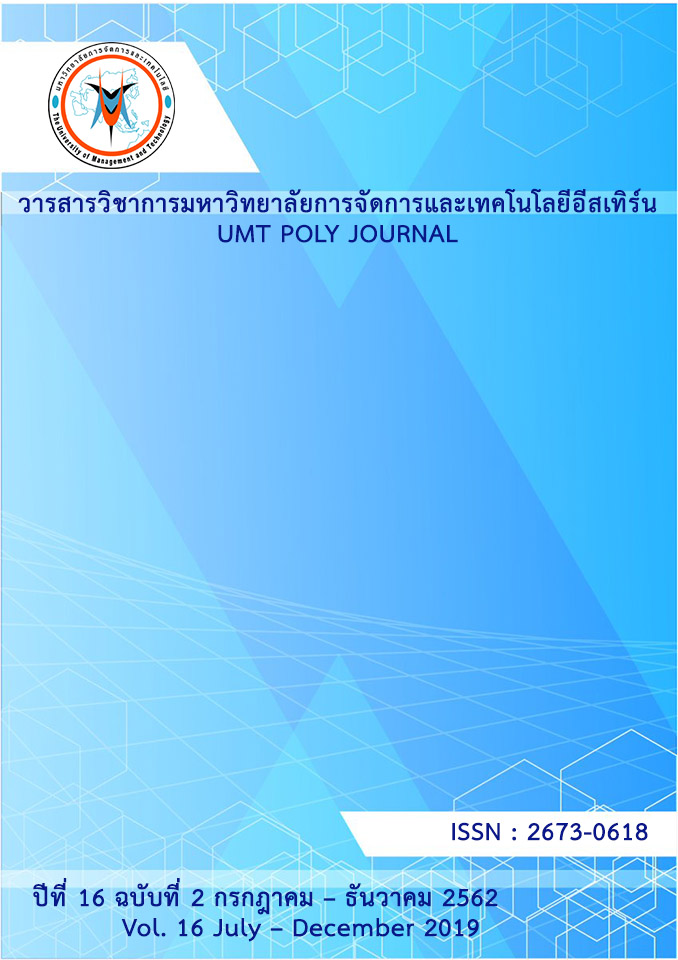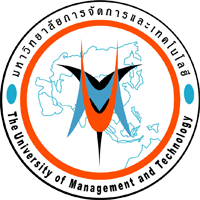ปัจจัยที่ส่งผลต่อมาการมาใช้บริการอย่างต่อเนื่องของนักท่องเที่ยววัยรุ่นชาวจีนที่เคยมาท่องเที่ยวประเทศไทย กรณีศึกษา น้ำพุร้อนโป่งน้ำร้อน, จังหวัดจันทบุรี, ประเทศไทย
คำสำคัญ:
การท่องเที่ยวเชิงสุขภาพ, น้ำพุร้อน, ความตั้งใจต่อเนื่องบทคัดย่อ
การศึกษาครั้งนี้มีวัตถุประสงค์เพื่อ (1) เพื่อทราบอันดับของปัจจัยที่มีอิทธิพลต่อความตั้งใจต่อเนื่องของนักท่องเที่ยววัยรุ่นชาวจีนที่เคยเดินทางมาประเทศไทย กรณีศึกษาบ่อน้ำพุร้อนโป่งน้ำร้อน จังหวัดจันทบุรี ประเทศไทย (2) เพื่อทราบผลกระทบทางตรงและผลกระทบทางอ้อมของปัจจัยที่มีอิทธิพลต่อความตั้งใจต่อเนื่องของนักท่องเที่ยววัยรุ่นชาวจีนที่เคยเดินทางมาประเทศไทย กรณีศึกษาบ่อน้ำพุร้อนโป่งน้ำร้อน จังหวัดจันทบุรี ประเทศไทย และ (3) เพื่อพัฒนาแบบจำลองการวิเคราะห์ตัวแบบสมการเชิงโครงสร้างปัจจัยที่มีอิทธิพลต่อความตั้งใจต่อเนื่องของการท่องเที่ยววัยรุ่นชาวจีนที่เคยเดินทางมาประเทศไทย การวิจัยครั้งนี้ใช้การวิจัยเชิงปริมาณ ใช้วิธีการสุ่มตัวอย่างน่าจะเป็นโดยการสุ่มแบบแบ่งชั้น แบบสอบถามประกอบด้วยสามส่วน ขนาดตัวอย่างคือ 400 ข้อมูลจะถูกวิเคราะห์โดยใช้สถิติเชิงพรรณนาและการวิเคราะห์เส้นทาง โดยรวมของตัวแปรอยู่ในระดับ“Average” ระดับการจัดอันดับจากค่า “Mean”ของตัวแปรทั้งหมดประกอบด้วยดังนี้: อันดับที่ 1 คือ ความน่าเชื่อถือ (Trust)และอันดับที่ 6 คือการยืนยัน (Confirmation) ตัวแปรอิสระทั้งห้ามีความสัมพันธ์เชิงบวกกับความตั้งใจต่อเนื่อง (Continuance Intention), ความพึงพอใจ(Satisfaction) เป็นตัวแปรที่แข็งแกร่งที่สุดที่มีอิทธิพลต่อความตั้งใจต่อเนื่อง (Continuance Intention)ในทางตรง การยืนยัน(Confirmation)เป็นตัวแปรที่แข็งแกร่งที่สุดที่มีผลต่อความตั้งใจต่อเนื่อง (Continuance Intention)ในทางอ้อม ปัจจัยทั้งหมดสามารถนำมาใช้ในการพัฒนาแบบจำลองการวิเคราะห์แบบจำลองสมการโครงสร้างปัจจัยที่มีอิทธิพลต่อความตั้งใจต่อเนื่อง โดยรวมแล้วข้อมูลบ่งชี้ว่าเหมาะสมอย่างยิ่งสำหรับรูปแบบการทดสอบ และสมมติฐานทั้งเจ็ดข้อได้รับการสนับสนุนจากการทบทวนวรรณกรรม
Downloads
เอกสารอ้างอิง
Alain, Y. and Loong, C. (2013). Understanding Mobile Commerce Continuance Intentions: An Empirical Analysis of Chinese Consumers. Journal of Computer Information Systems, 53(4), 22-30.
Aries, S., Younghoon, C., and Youngwook H. (2015). Determinants of continuance intention to use the smartphone banking services: An extension to the expectation-confirmation model. Industrial Management & Data Systems, 116(3), 508-525.
Cheolho, Y. and Erik, R. (2015). Understanding Continuance Use in Social Networking Services. Journal of Computer Information Systems, 55(2). 1-8.
Chun, L. L. and Ming-Kuei, H. (2014). A Nonlinear Relationship Between The Consumer Satisfaction And The Continued Intention To Use SNS Services: The Moderating Role Of Switching Cost. International Journal of Electronic Business Management, 12(2), 90-101.
Comegys, C., Hannula, M. and Va¨isa¨nen, J. (2009). Effects of consumer trust and risk on onlinepurchase decision-making: a comparison of Finnish and United States students, International Journal of Management, 26(2), 295-308.
Gefen, D. and Straub, D. W. (2004). Consumer trust in B2C e-Commerce and the importance of social presence: experiments in e-Products and e-Services. Omega, 32(6), 407-424.
Gefen, D., Karahanna, E. and Straub, D. W. (2003). Trust and TAM in Online Shopping: An Integrated Model. MIS Quarterly.
Dawei, S. and Weiwei, W. (2017). Understanding mobile shopping consumers’ continuance intention. Industrial Management & Data Systems, 117(1), 13-227.
Dong Hong, Z, Ya Ping, C. and An, C. (2015). Effects of free gifts with purchase on online purchase satisfaction: The moderating role of uncertainty. Internet Research, 25(5). 690-706.
Davis, F. D., Bagozzi, R. P. and Warshaw, P. R. (1989). User acceptance of computer technology: a comparison of two theoretical models. User Acceptance of Computer Technology: A Comparison of Two Theoretical Models, 982-1003.
Davis, F. D., Bagozzi, R. P. and Warshaw, P. R. (1992). Extrinsic and intrinsic motivation to use computers in the workplace. Journal of Applied Social Psychology, 22(14), 1111-1132.
Gefen, D. (2000), “E-commerce: the role of familiarity and trust”, Omega: The International Journal of Management Science, 28, 725-37.
Global Wellness Institute. (2013 & 2014). The Global Wellness Tourism Economy Report, 2013 & 2014June 2015
Guo, Y., Barnes, S.J., and Le-Nguyen, K. (2015). Consumer Acceptance IT Products: An Integrative Expectation-confirmation Model. AMCIS.
Guopeng, Y., Ling, Z. and Xusen, C. (2013). Continuance Usage of Localized Social Networking Services: A Conceptual Model and Lessons from China. Journal of Global Information Technology Management, 16(3), 7-30.
Innis, H. (1991). The Bias of Communication. Communication. Information Médias Théories, 17, 264-267.
Huanhuan, C, Jinhu, J., Lih‐Bin, O., Hao, L., Xiuwu, L. and Zhiwu, C. (2013). A Maslow's hierarchy of needs analysis of social networking services continuance. Journal of Service Management, 24(2), 170-190.
Hui-Mei, H., Jack Shih-Chieh, H., Shih-Yu, W. and I-Chiu, C. (2016). Exploring the Effects of Unexpected Outcome on Satisfaction and Continuance Intention. Journal of Electronic Commerce Research, 17(3).
Hong, M. E-S., Jacky, F. L. and Robin, S. S. (2006). Transferring Organizational Learning Systems to Japanese Subsidiaries in China. Journal of Management Studies, 43(5), 1027-1058.
John W. Best. (1970). Research in Education. 3 rd. th. New Jersey: Prentice – Hall Inc.
June, L. (2014). Are Personal Innovativeness and Social Influence Critical to Continue with Mobile Commerce? Internet Research, 24(2).
Lee, M. H. and Tsai, C. C. (2010). Exploring teachers’ perceived self-efficacy and technological pedagogical content knowledge with respect to educational use of the World Wide Web. Instructional Science, 38(1), 1–21.
Locke, E.A. (1976). The Nature and Causes of Job Satisfaction. In: Dunnette, M.D., Ed., Handbook of Industrial and Organizational Psychology, 1, 1297-1343.
Moungho. P, Jaehyeon, J. and Heejun, P. (2017). Understanding Mobile Payment Service Continuous Use Intention: An Expectation - Confirmation Model and Inertia. Quality Innovation Prosperity, 21(3), 78-94.
Nancy, L., D., Harrison, M. and Jason, B. T. (2014). Incorporating trust-in-technology into Expectation Disconfirmation Theory. The Journal of Strategic Information Systems, 23(2), 128-145.
Norshidah, M., Ramlah, H., Nurul, H., Ahmad, Z. and Hanif, H. (2014). Insights into individual's online shopping continuance intention. Industrial Management & Data Systems, 114(9), 1453-1476.
Oliver, R. L., & Bearden, W. O. (1985). Disconfirmation processes and consumer evaluations in product usage. Journal of Business Research, 13(3), 235-246.
Reid and Reid. (2010). The expressive and conversational affordances of mobile messaging. Behaviour and Information Technology. 29(1), 3-22.
Robert, A. Westbrook and Oliver, R. L. (1981). Developing Better Measures of Consumer Satisfaction: Some Preliminary Results, in NA - Advances in Consumer Research, Kent B. Monroe, Ann Abor, MI: Association for Consumer Research, 8, 94-99.
Shahriar, A., Pradeep, R. and John, D. (2012). Continuance of mHealth Services at the Bottom of the Pyramid: The Roles of Service Quality and Trust. Electronic Markets, 23(1), 29–47.
Stauss, B., & Neuhaus, P. (1997). The qualitative satisfaction model. International Journal of Service Industry Management, 8(3), 236-249.
Zhou, T. and Lu, Y. (2011). Examining mobile instant messaging user loyalty from the perspectives of network externalities and flow experience. Computers in Human Behavior, 27(2), 883-889.
Taqwa, H., Min-Tsai, L. and Shih-Chih, C. (2016). An Empirical Study on the Impact of Information System Quality on Software as a Service. Global Business & Management Research. 2016, 8(3), 43-54, 12p.
Wen, Y., Parrish, J.Z., He, R., Zhai, R.G.. and Kim, M.D. (2011). Nmnat exerts neuroprotective effects in dendrites and axons. Molecular and Cellular Neuroscience, 48(1), 1-8.
DeLone, McLean, E. R. and William, H. (2003). The DeLone and McLean Model of Information Systems Success: A Ten-Year Update. Journal of Management Information Systems, 19(4):9-30
Xin, T., Yongbeom, K. (2015). User acceptance of SaaS-based collaboration tools: a case of Google Docs. Journal of Enterprise Information Management, 28(3), 423-442.
Yuan, S., Ling, L., Xinmin, P., Yi, D. and Stuart, J. B. (2013). Understanding Chinese users' continuance intention toward online social networks: An integrative theoretical model. Electronic Markets, 24. 57-66.
Yung-Ming C. (2014). Extending the expectation-confirmation model with quality and flow to explore nurses’ continued blended e-learning intention. Information Technology & People, 27(3). 230-258.
Deng, Z., Lu, Y., Wei, K.K. and Zhang, J. (2010). Understanding customer satisfaction and loyalty: An empirical study of mobile instant messages in China. International Journal of Information Management, 30(4), 289-300.
ดาวน์โหลด
เผยแพร่แล้ว
ฉบับ
ประเภทบทความ
สัญญาอนุญาต
ประกาศลิขสิทธิ์
เนื้อหาและข้อมูลในบทความที่ลงตีพิมพ์ในวารสารวิชาการมหาวิทยาลัยการจัดการและเทคโนโลยีอีสเทิร์น ถือเป็นข้อคิดเห็นและความรับผิดชอบของผู้เขียนบทความโดยตรง ซึ่งกองบรรณาธิการวารสารไม่จำเป็นต้องเห็นด้วยหรือร่วมรับผิดชอบใด ๆ
บทความ ข้อมูล เนื้อหาหรือรูปภาพ ฯลฯ ที่ได้รับการตีพิมพ์ในวารสารวิชาการมหาวิทยาลัยการจัดการและเทคโนโลยีอีสเทิร์น ถือเป็นลิขสิทธิ์ของวารสารวิชาการมหาวิทยาลัยการจัดการและเทคโนโลยีอีสเทิร์น หากบุคคลหรือหน่วยงานใดต้องการนำข้อมูลทั้งหมดหรือบางส่วนไปเผยแพร่ต่อหรือเพื่อกระทำการใด ๆ จะต้องได้รับอนุญาตเป็นลายลักษณ์อักษรจากวารสารวิชาการมหาวิทยาลัยการจัดการและเทคโนโลยีอีสเทิร์นก่อนเท่านั้น




